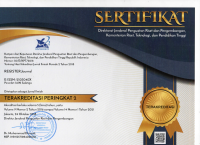The Influence of Students' Creativity to Construct Sentences toward Their Speaking Skill
Abstract
One of the obligated English materials studied by all students of Indonesian universities is speaking English because English is one of the international languages used to communicate in the world. Moreover, many work fields offered from abroad to Indonesian scholars obligate them to speak English well. Having capability to speak English well is not an easy task. There are some factors influencing the ability of speaking. One of the factors is creativity. Therefore, this research is concerned on investigating the influence of students’ creativity to create sentences toward their speaking skill. This article only discusses one of the three objectives of this quasi experimental research. It is whether or not the students having high creativity have high speaking skill. The data of this research consisted of the scores of creativity test and speaking test. The data of speaking scores were categorized into two, scores of the students having high and low creativity. After those data were normal and homogeneous, then, analyzed using F-test ANOVA. The difference between rows is significant because Fo between rows (1125.64) is higher than Ft (4.11) at the level of significance α= 0.05. The mean score of B1 (78.9) is higher than that of B2 (60.85), it can be said that the speaking skill of students having high creativity is higher than those having low creativity. Thus, it can be concluded that students’ creativity influences their speaking skill.
Keywords: Influence; Students’ Creativity; Speaking Skill
Full Text:
PDFReferences
Adriana, R., Melendez, M., Gandy, M., Zavala, G. Q., & Mendez, R. F. (2014). Teaching Speaking Strategies To Beginners. European Scientific Journal, 1(February), 1857–7881.
Afrizal, M. (2015). a Classroom Action Research: Improving Speaking Skills Through Information Gap Activities. English Education Journal, 6(3), 342–355.
Al Othman, F. H. M., & Shuqair, K. M. (2013). The Impact of Motivation on English Language Learning in the Gulf States. International Journal of Higher Education, 2(4), 123–130. https://doi.org/10.5430/ijhe.v2n4p123
Arham, R., Yassi, A. H., & Arafah, B. (2016). The Use of Role Play to Improve Teaching Speaking, 6(3), 239–241.
Becker, C., & Roos, J. (2016). An approach to creative speaking activities in the young learners’ classroom. Education Inquiry, 7(1), 9–26. https://doi.org/10.3402/edui.v7.27613
Dewi, R. S., Kultsum, U., & Armadi, A. (2016). Using Communicative Games in Improving Students’ Speaking Skills. English Language Teaching, 10(1), 63. https://doi.org/10.5539/elt.v10n1p63
Efrizal, D. (2012). Improving Students ’ Speaking through Communicative Language Teaching Method at Mts Ja-alhaq , Sentot Ali Basa Islamic Boarding School of Bengkulu , Indonesia Dedi Efrizal State Institute of Islamic Studies ( IAIN ) Bengkulu , Indonesia Abstract A . Intro. International Journal of Hhmanities and Social Science, 2(20), 127–134.
Eragamreddy, N. (2013). Teaching Creative Thinking Skills. International Journal of English Language & Translation Study, 1(2), 124–145.
Kaminskienė, L., & Kavaliauskienė, G. (2014). Attitudes To Improving Speaking Skills By Guided Individual Activities. COACTIVITY: Philology, Educology, 22(1), 39–48. https://doi.org/10.3846/cpe.2014.04
Kim, K. H. (2011). The Creativity Crisis: The Decrease in Creative Thinking Scores on the Torrance Tests of Creative Thinking. Creativity Research Journal, 23(4), 285–295. https://doi.org/10.1080/10400419.2011.627805
Lin, Y.-S. (2011). Fostering Creativity through Education – A Conceptual Framework of Creative Pedagogy. Creative Education, 2(3), 149–155. https://doi.org/10.4236/ce.2011.23021
Maher, A., & Nakhalah, M. Al. (2016). Problems and Difficulties of Speaking That Encounter English Language Students at Al Quds Open University. International Journal of Humanities and Social Science Invention ISSN (Online, 5(12), 2319–7722. Retrieved from www.ijhssi.org
Mart, C. T. (2012). Developing Speaking Skills through Reading. International Journal of English Linguistics, 2(6), 91–96. https://doi.org/10.5539/ijel.v2n6p91
Mkpanang, J. T. (2016). Influence of Creative Style and Gender on Students ’ Achievement in Physics. Journal of Education and Practice, 7(12), 42–46.
Negahi, M., Nouri, N., & Khoram, A. (2015). The Study of Learning Styles , Thinking Styles , and English Language Academic Self-efficacy among the Students of Islamic Azad University of Behbahan Considering Their Field of Study and Gender. Theory and Practice in Language Studies, 5(8), 1722–1729. https://doi.org/http://dx.doi.org/10.17507/tpls.0508.25
Nurul Amilin, R., Mazni, M., Sulia Masturina, C. R., Norhayati, H., & Nor Zaitolakma, A. S. (2011). Students’ Diverse Learning Styles in Learning English As A Second Language. International Journal of Business and Social Science, 2(19), 179–186.
Oradee, T. (2013). Developing Speaking Skills Using Three Communicative Activities (Discussion, Problem-Solving, andRole-Playing). International Journal of Social Science and Humanity, 2(6), 533–535. https://doi.org/10.7763/IJSSH.2012.V2.164
Ramezani, R., Larsari, E. E., & Kiasi, M. A. (2016). The Relationship between Critical Thinking and EFL Learners’ Speaking Ability. English Language Teaching, 9(6), 189. https://doi.org/10.5539/elt.v9n6p189
Mulya,R.A., Adnan, A., & Ardi, R. (2013). The Effect Of Problem Based Learning Strategy Toward Students’ Speaking Ability At The First Grade Of SMAN 1 Enam Lingkung. Journal of English Language Teaching, 2(1), 314-323.
Sosyal, A., & Dergisi, A. (2013). Gökçe DİŞLEN THE REASONS OF LACK OF MOTIVATION FROM THE STUDENTS’ AND TEACHERS’ VOICES. The Journal of Academic Social Science, 35–45.
Baghaei, S. & Riasati, M.J. (2013). An Investigation into the Relationship Between Teachers’ Creativity and Students’ Academic Achievement: A Case Study of Iran EFL Context , Middle-East Journal of Scientific Research ,14 (12): 1576-1580. doi: 10.5829/idosi.mejsr.2013.14.12.803
Thakur, D. A., & Shekhawat, M. (2014). Importance of Teaching Innovation & Creativity in Engineering and Management. International Journal of Engineering Trends and Technology, 14(3), 153–157. https://doi.org/10.14445/22315381/IJETT-V14P230
Trivedi, K., & Bhargava, R. (2010). Relation of Creativity and Educational Achievement in Adolescence. Relation of Creativity and Educational Achievement in Adolescence, 1(2), 85–89.
Tsai, K. C. (2012). The Value of Teaching Creativity in Adult Education. International Journal of Higher Education, 1(2), 84–91. https://doi.org/10.5430/ijhe.v1n2p84
Yager, S. O., Hacieminoglu, E., & Yager, R. E. (2012). The Role of Student and Teacher Creativity in Aiding Current Reform Efforts in Science and Technology Education. National Forum of Applied Educational Research Journal, 25(3), 1–24.
Zhu, B., & Zhou, Y. (2012). A study on students’ affective factors in Junior high school English teaching. English Language Teaching, 5(7), 33–41. https://doi.org/10.5539/elt.v5n7p33
DOI: https://doi.org/10.18326/rgt.v11i1.1-18
Refbacks
- There are currently no refbacks.
Copyright (c) 2018

This work is licensed under a Creative Commons Attribution-ShareAlike 4.0 International License.










